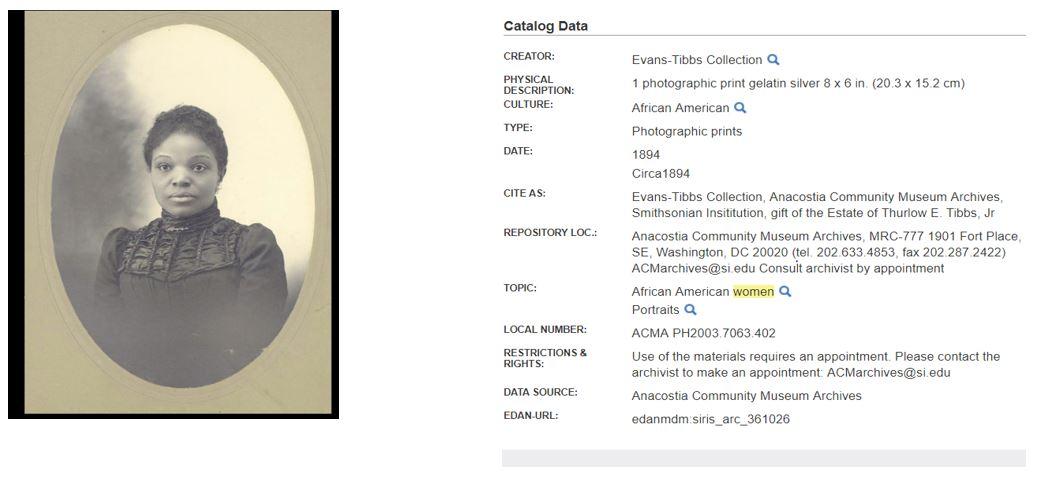Create Your Own Women’s History Museum
Students will research a woman/group of women. They will then find an object associated with their woman/group of women and create a museum exhibit.
2-3 class periods and 1-2 nights of homework
Students will learn how to thoroughly research a topic and create a museum exhibit.
Part One: Finding Primary Sources (Individually)
- One person per group will create a Google document to share with her fellow students.
- Each group will be assigned one of the Historical Topics/Time Periods listed below and will be given an accompanying list of five women from their respective time period:
- Historical Topic/Time Period
- Colonial Era
- Civil War & Reconstruction
- Progressive Era
- World War II
- Civil Rights
- Culture & Arts
- Sports
- Historical Topic/Time Period
- Go to National Women’s History Museum: Topics, Exhibits, or Biographies.
- Each individual will choose one of the five women from their groups historical topics /time period to research and will choose an artifact which best represents the historical importance of the woman.
- Individuals will incorporate their research into the Group’s shared Google document. ALL WORK SHOULD BE KEPT IN ONE DOCUMENT.
- Artifacts can be researched and selected through the Smithsonian's Collections Website and can be searched by topic or object.
- Snip the image of the artifact into your group’s Google document
- Include information according to the Example below:

Part Two: Create an Exhibition (Group)
- Create a title for your exhibition such as “Women of Colonial America”
- As a group choose ONE of the artifacts to be used as the MAIN object of your time period. The object is an artifact from the time period; art, movie poster, letter, a flag, fashion ect.
- MAIN object will be a symbol of your whole exhibition, IT cannot be one of the women. It should be an artifact that connects the women.
- As a group look through the Smithsonian's Collection to find the MAIN object
- Create an information panel on your historical time period which represents a woman’s life at the time.
- Create a label for the MAIN OBJECT.
Part Three: Secondary Object (Individual)
- You will choose ONE of the five women to be your secondary object.
- You must research her background and her historical importance.
- Include an artifact from the time that reflects her background and importance.
- You must include a picture of her.
- Create an information panel with label for your object.
Part Four: Exhibition
- As a group, print color photos of each of your objects (Secondary & Main)
- Print your labels and tombstones
- Back it with color paper
- Hang the objects, labels, and tombstones in the hallway.
- Optional: Have a “gallery opening” for students and parents
Group 1: Colonial and Revolutionary Era
Group 2: Civil War & Reconstruction
- Dorothea Dix
- Harriet Beecher Stowe
- Harriet Tubman
- Sojourner Truth
- Angelina Grimké Weld/Sarah Moore Grimké
- Clara Barton
Group 3: Progressive Era
- Jane Addams
- Mary Church Terrell
- Elizabeth Cady Stanton
- Susan Brownell Anthony
- Ida B. Wells-Barnett
- Mary Harris Jones
Group 4: World War II
Group 5: Civil Rights
Group 6: Culture & Arts
Project Rubric
|
Category |
5 |
4 |
3 |
0-2 |
|
Creativity/ Presentation value |
Presentation is unique, different, or contains some creative and relevant elements that make the exhibition stand out. |
Presentation creativity is above average and contains some distinct elements that are eye-catching. |
Presentation creativity is average |
Creativity is significantly lacking, presentation is boring/ straightforward/ black and white |
|
Neatness/ Consistency |
Project is clean, well-constructed, and visually appealing. Museum-quality presentation |
Project is neat, with a minor mistake or two. Might have a slight inconsistency with other group members’ projects, but nothing major. |
Neatness is average, a few mistakes in presentation. Project may be slightly inconsistent with that of other group members. |
Project is sloppy, unclean, hard to make sense of, messy, etc. Project is inconsistent with the design of other group members’ projects. |
|
Dates and other essential information |
Tombstone contains all dates and essential information about the artifacts. |
Tombstone contains some essential information, but may be missing something that would have been helpful to understand the artifact |
|
Dates and other essential information are missing or incorrect. |
|
Significance |
Writing clearly explains the significance of the woman in American History. |
Writing explains the general significance of the woman, but spends too much time on basic factual information. |
Writing relays basic factual information, but does not give the woman significance. |
Writing is factually inaccurate, missing, or contains significant flaws. |
